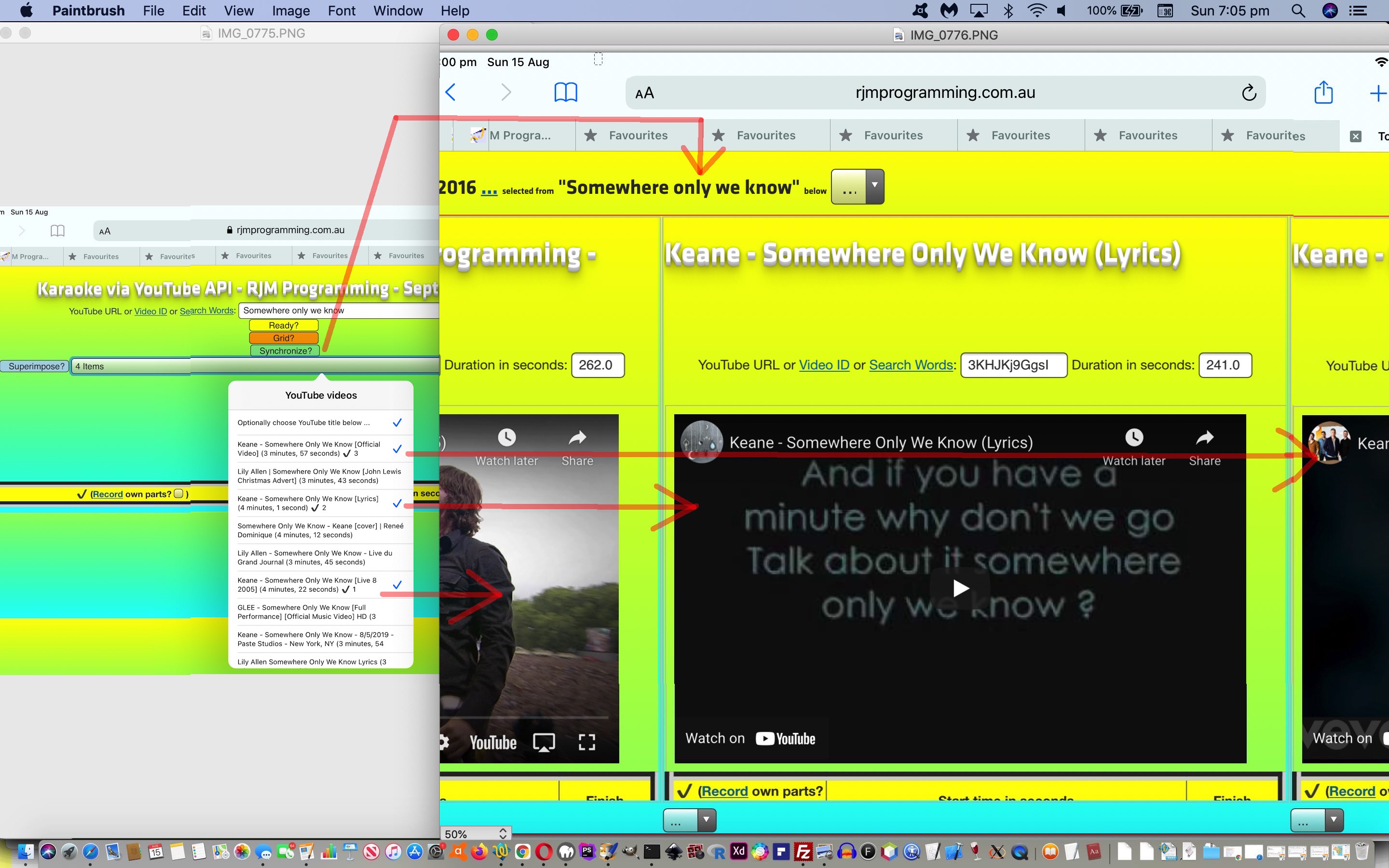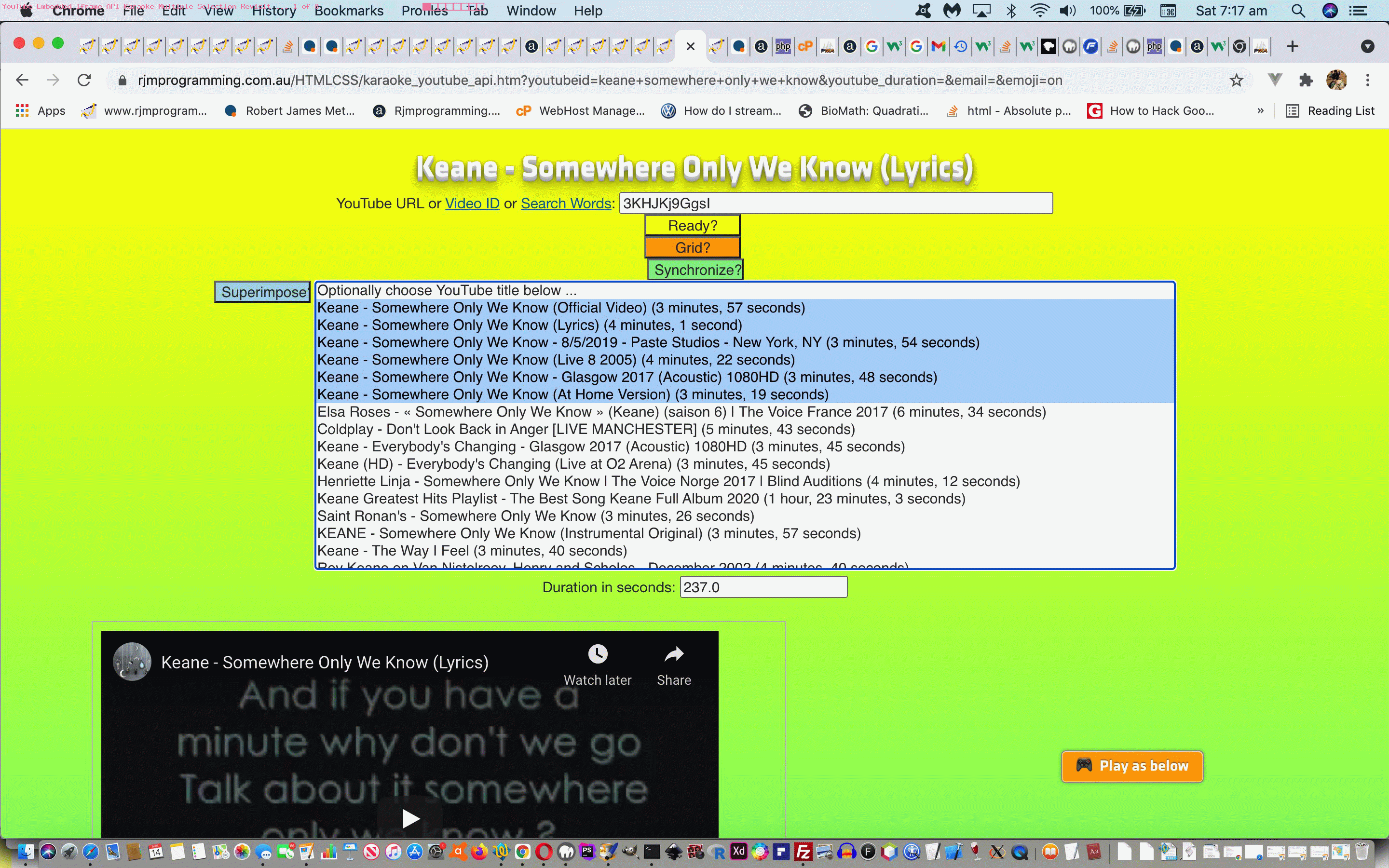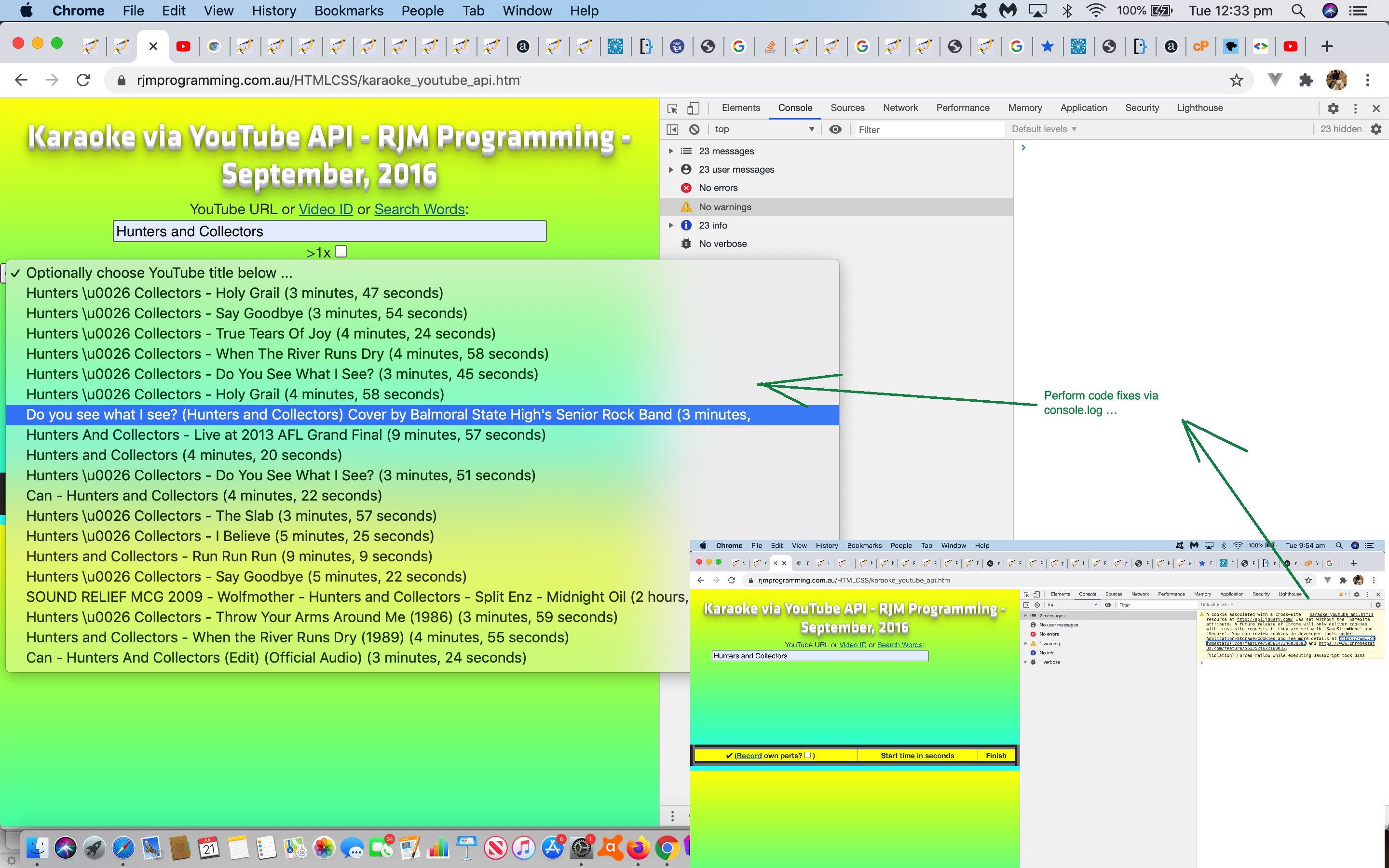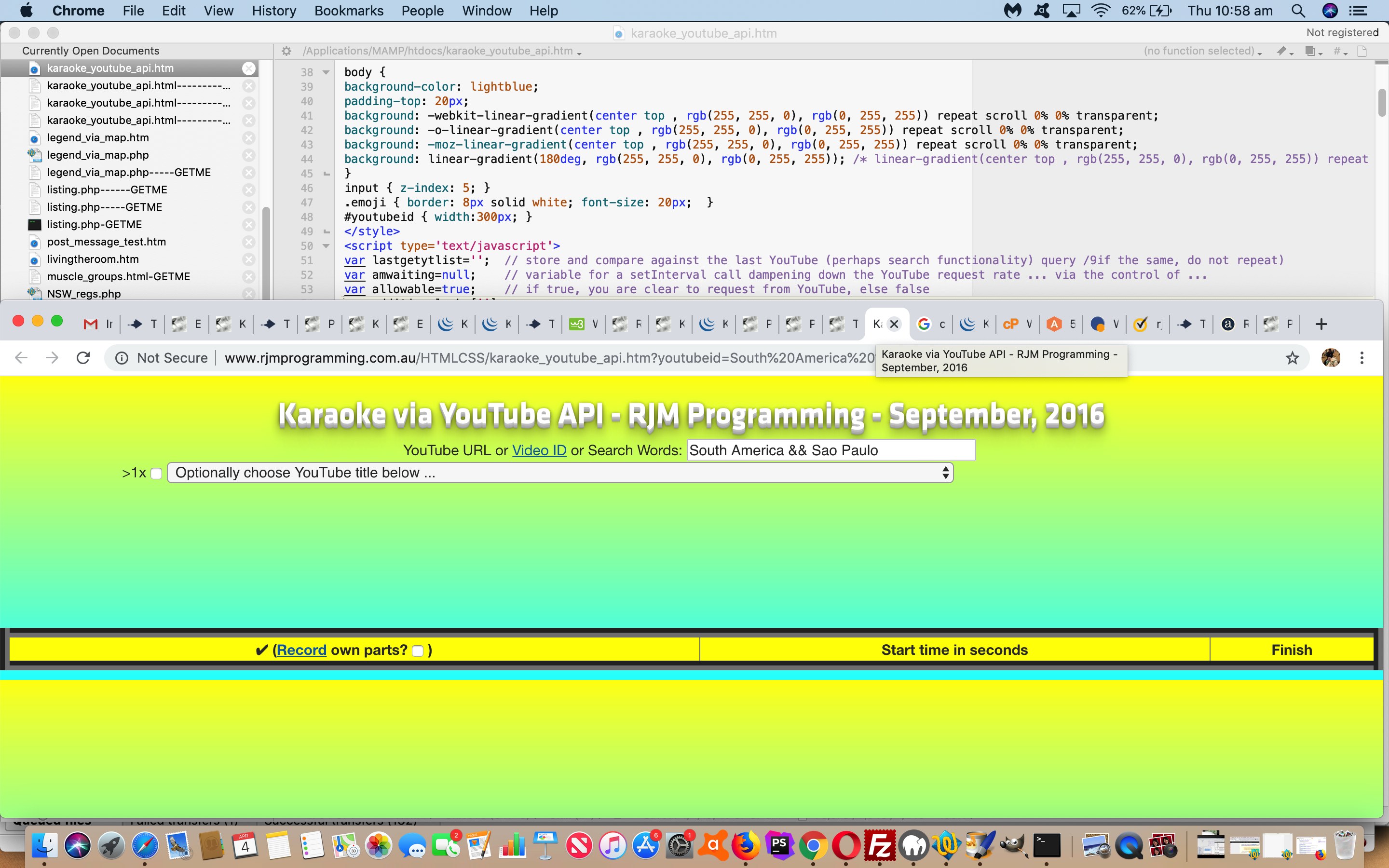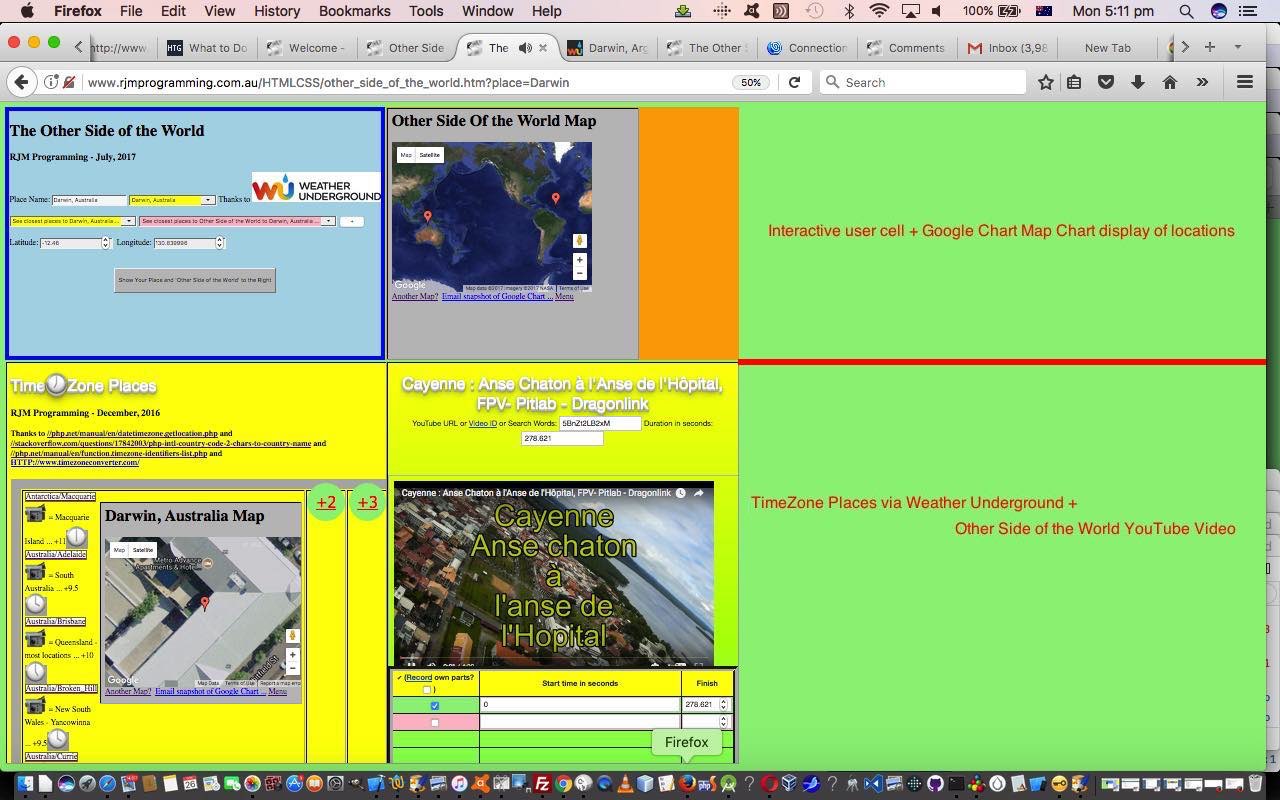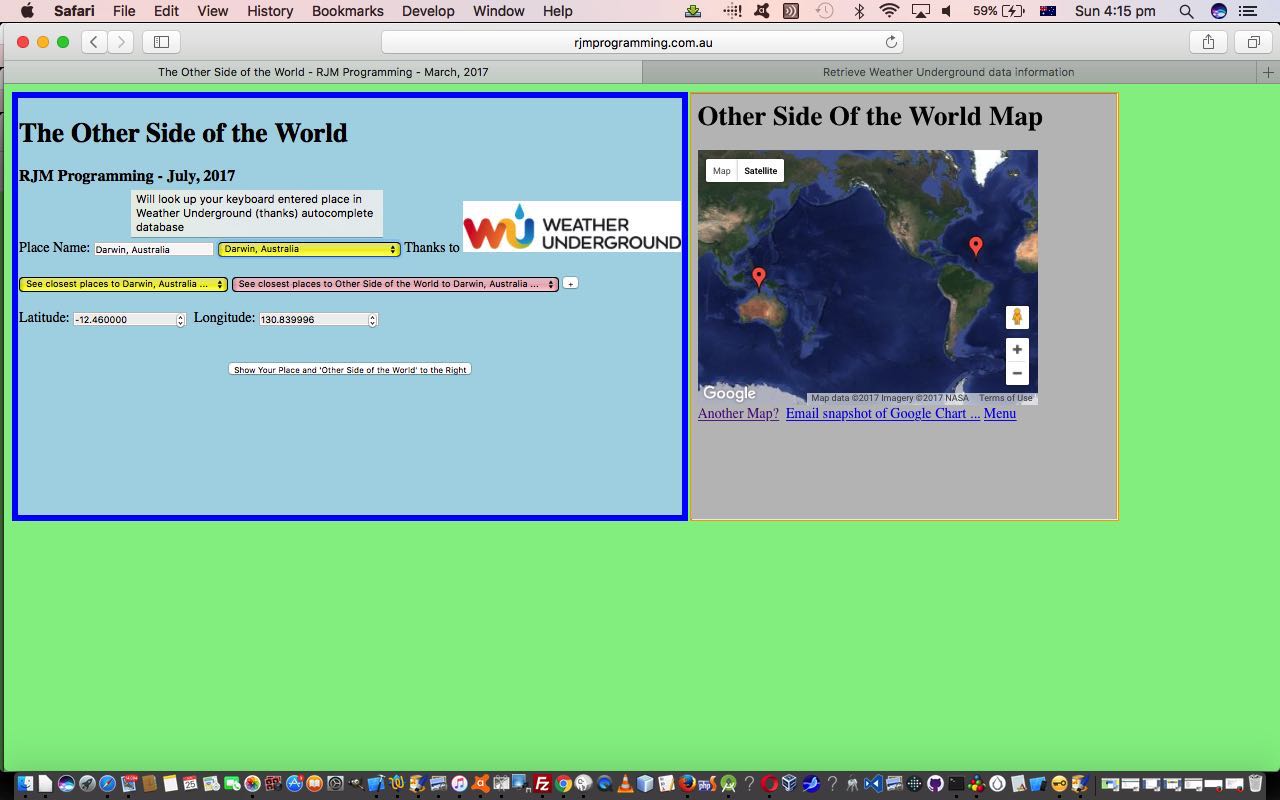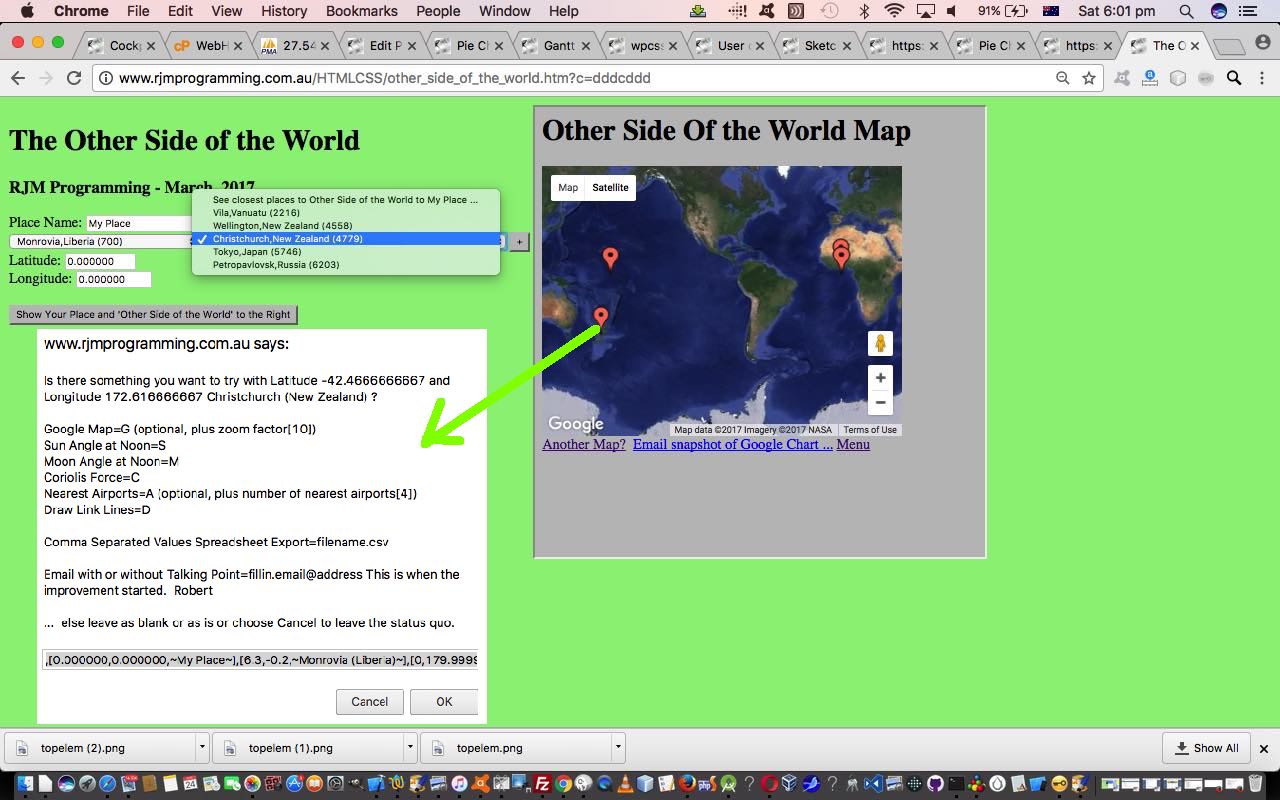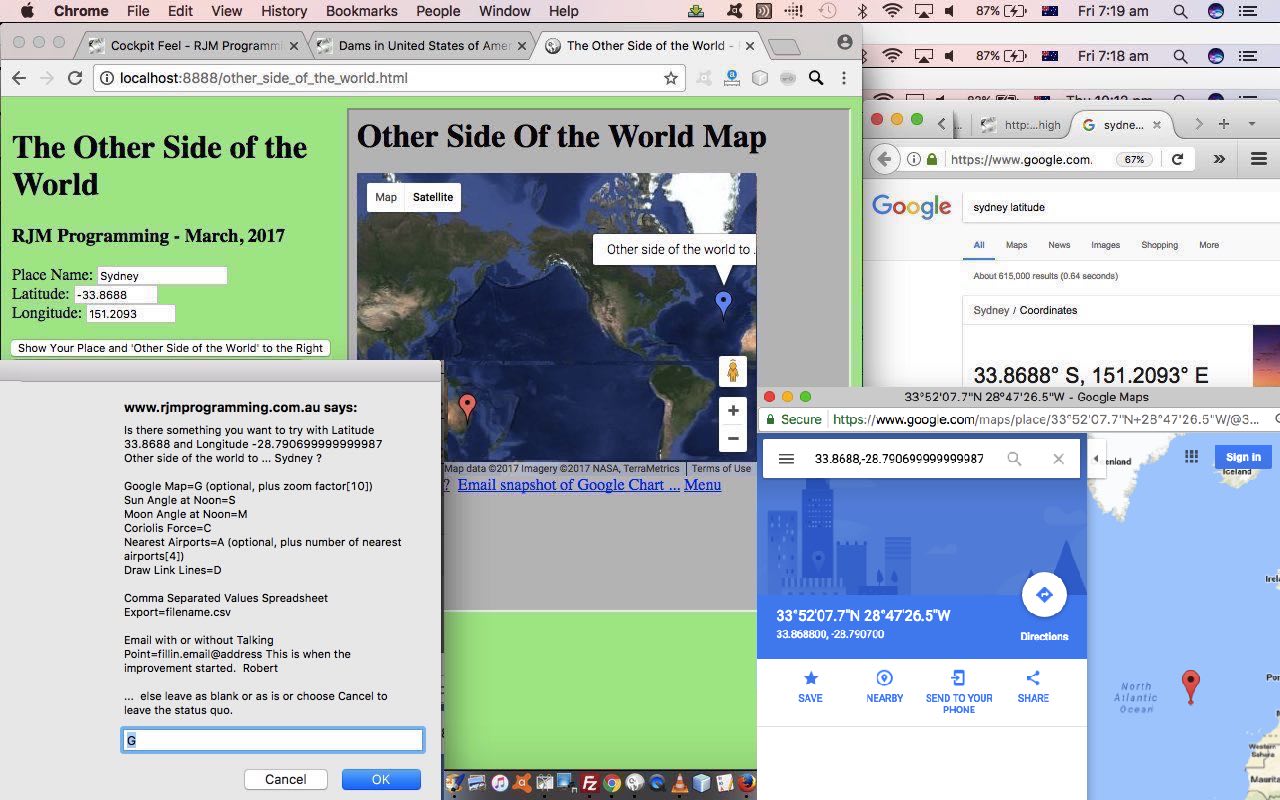Perhaps you were around when we recently presented the One or Several Did You Know Quiz Mobile Cursor CSS Tutorial where we created …
- some non-mobile platform logic to allow for a select (ie. dropdown) element with multiple selection honour the order in which a user enters single click selections … and today we do this in the project of yesterday’s Karaoke YouTube Video Search Improvement Tutorial … as well as …
- some mobile platform logic to allow for a select (ie. dropdown) element with multiple selection honour the order in which a user enters single click selections, focussing on select element “onchange” event logic as per …
var lastajaxs='';
// Within select event "onchange logic we have calling Javascript code ...
if (navigator.userAgent.match(/Android|BlackBerry|iPhone|iPad|iPod|Opera Mini|IEMobile/i) && lastajaxs != '') {
preajaxswatch(); //setTimeout(preajaxswatch,100);
} else if (navigator.userAgent.match(/Android|BlackBerry|iPhone|iPad|iPod|Opera Mini|IEMobile/i)) {
preajaxswatch();
}
// ... calling the called function ...
function preajaxswatch() {
var tickis=' ' + String.fromCodePoint(10004);
var appis='';
var tcnt=1;
if (navigator.userAgent.match(/Android|BlackBerry|iPhone|iPad|iPod|Opera Mini|IEMobile/i)) {
rep+=' --- ';
if (document.getElementById('ajaxs') && ourmto) {
rep+=' .-. ';
var sin=document.getElementById('ajaxs');
var lajaxs='', lajaxsd='';
for (var ii=0; ii<sin.options.length; ii++) {
if (sin.options[ii].selected) {
if (sin.options[ii].value != '' && (',' + lastajaxs + ',').indexOf(',' + sin.options[ii].value + ',') != -1) {
lajaxs+=lajaxsd + sin.options[ii].value; lajaxsd=','; tcnt++;
if (sin.options[ii].innerText.indexOf(tickis) == -1) {
sin.options[ii].innerText+=tickis + ' ' + eval(1 + eval('' + (',' + lastajaxs).split(',' + sin.options[ii].value)[0].substring(1).split(',').length));
}
}
}
}
for (var iii=0; iii<sin.options.length; iii++) {
if (sin.options[iii].selected) {
if (sin.options[iii].value != '' && (',' + lastajaxs + ',').indexOf(',' + sin.options[iii].value + ',') == -1) {
appis+=lajaxsd + sin.options[iii].value;
lajaxs+=lajaxsd + sin.options[iii].value;
lajaxsd=',';
if (sin.options[iii].innerText.indexOf(tickis) == -1) {
sin.options[iii].innerText+=tickis + ' ' + tcnt;
}
tcnt++;
}
}
}
if (lajaxs != '' && lajaxs != lastajaxs && (eval('' + lajaxs.split(',').length) != eval('' + lastajaxs.split(',').length) || eval('' + lajaxs.length) != eval('' + lastajaxs.length))) {
//if (lajaxs.indexOf(',') != -1) { document.getElementById('myh1').innerHTML+=(rep + ' 2:' + lajaxs); }
if (appis != '') {
lastajaxs+=appis;
} else {
lastajaxs=lajaxs;
}
rep+=(' 2:' + lastajaxs);
ajaxclist=lastajaxs;
ajaxoncnt=eval('' + ajaxclist.split(',').length);
ajaxf='';
}
}
}
}
Again the changed karaoke_youtube_api.htm HTML and Javascript code’s live run link could be worth your perusal.
Previous relevant Karaoke YouTube Video Search Improvement Tutorial is shown below.
We need to thank last Friday’s ABC The Drum episode’s last story about the wonderful Hummingsong Community Choir, in turn leading me to this Australia’s Got Talent YouTube video …
… and onto some research into Keane (the band who wrote that “Somewhere Only We Know” song that had stayed in my mind, quietly, for a very long time) and others like Lily Allen who have covered it.
Software came into it with me wanting to sequence some video versions of that song, and some unexpected surprises when submitting our inhouse Karaoke YouTube API for Iframe interfacer to the task where we found …
- issues when ( and ) appear in a YouTube video title … and …
- issues with video duration calculations with the more recent minutes and seconds format we use when …
- setting the “>1” checkbox after a YouTube video search dropdown and selecting several videos and then choosing out of …
- Ready … each fills a window and might autoplay synchronously
- Grid … each sits within a 3×3 grid table and does not attempt autoplay
- Synchronize … each sits in a table cell of a window and might autoplay synchronously
- Superimpose … each sits on top of the last table cell in a window and might autoplay synchronously
… modes of play, where “Ready” and “Synchronize” needed further tweaking
And so, we improve on the recent Karaoke YouTube Video Search Update Tutorial, where helping out is a changed stop_start_youtube.html for the changed karaoke_youtube_api.htm HTML and Javascript code’s live run link.
Would you like to overdose on “Somewhere Only We Know”? Try selecting your own from this link.
Previous relevant Karaoke YouTube Video Search Update Tutorial is shown below.
Way back at the time of writing Karaoke YouTube Video Search Error 503 Tutorial we were first allowing for …
- YouTube website search functionality … augment that of …
- API for Iframe embedded videos usage
… the latter “original intention” functionality only kicking in once a YouTube video of interest is found. In other words, finding what you want is beyond the scope of the API here, unless you (the user) settle for a channel or user or playlist of interest.
We discovered this YouTube website search functionality integration failing the other day with our YouTube API integrated inhouse web application (via Karaoke thoughts), and discovered that the jQuery Ajax return data had changed.
Because it is jQuery Ajax debugging is best done using “console.log” we’ve had our arm twisted a lot lately, admitting (ie. we’re very fond of alert() Javascript windows around here, but alert() popup windows have that disadvantage of affecting window focus, and this can muck up what you are looking at, a bit like if we look at photons we interfere).
You’ll know you’re “getting into it” if your console.log statements get longer … as you can see a bit of below …
$.ajax({ url: dp + "legend_via_map.php",
data: {"url":dprefix + qsel},
type: 'get',
success: function(output) {
//document.title+=' success ' + output.indexOf('-describedby=') + ' ' + output.indexOf('described') + ' ';
//alert(output);
var teq=' title="';
var teqtwo='';
console.log('Success:');
var selc='', fosecs=0.0, afosecs=[], ifo=0, fofactor=1.0;
console.log('1');
var qqbits=output.split('v=');
console.log('2');
var qqtbits=output.split('-describedby='); //'/watch?'); // '"commandMetadata":{"webCommandMetadata":{"url":"/watch'); // '-describedby=');
if (qqbits.length > 1 && qqtbits.length == 1) {
qqtbits=output.split('watchEndpoint');
teq='"title":{';
teqtwo='"text":"';
}
console.log('3 ' + teq);
if (qqtbits.length == 1 && output.indexOf('503 ') != -1) { document.title+=' ... please try again later.'; }
console.log('4');
var qdelim=' ', tqbits, ttqqbits='', attqqbits=[], durbits='', adurbits;
console.log('5');
var q11=11;
var teqx='';
console.log('6');
var fgs='findings are ', sze='', is_okay=true, jis_okay=0;
console.log('7 ' + qqbits.length + ' ' + qqtbits.length);
if (qqbits.length > 1 && qqtbits.length == 1) {
console.log('error: ' + dprefix + qsel); window.open(dprefix + qsel, '_blank'); //, 'top=30,left=30,width=900,height=900');
}
for (var ifgs=1; ifgs<qqtbits.length; ifgs++) {
fosecs=0.0;
fofactor=1.0;
tqbits=qqtbits[eval(-1 + ifgs)].split(teq); //' title="');
ttqqbits=qqtbits[eval(-1 + ifgs)].split('v=')[eval(-1 + qqtbits[eval(-1 + ifgs)].split('v=').length)].substring(0,q11);
if (selc == '') { // && document.getElementById('ajax').innerHTML == '') {
// document.title+=' 1 ';
if (zeroplay == 0) {
// document.title+=' 2 ';
document.getElementById("myh1").innerHTML=document.getElementById("myh1").innerHTML.replace('Karaoke via ',ourvid + ' Video Lookup via ');
if (ttqqbits.indexOf('<') != -1) {
sze=" size=" + eval(-1 + qqtbits.length) + " ";
} else {
sze=" size=" + qqtbits.length + " ";
}
document.getElementById("myform").innerHTML+="<input type=hidden name=justplay id=justplay value=y></input>";
}
if (ttqqbits.indexOf('<') == -1) {
if (document.URL.indexOf('minimize=') != -1) { domin=true; }
selc=preselc + "<select" + sze + " title='YouTube videos' id=ajaxs ondblclick=dputy(this); onchange=puty(this);><option id=ominpossible value=>Optionally choose YouTube title below ...</option></select> <div id=placeforvideo></div>";
}
}
// more code follows ... until ...
}
if (is_okay) { document.getElementById('ajax').innerHTML=selc; if (document.URL.indexOf('pvostid=') !== -1) { if (parent.document.getElementById('ajaxs')) { parent.document.getElementById('ajaxs').innerHTML+='<option value=" ... and then ...">... and then ...</option>' + selc.split('</select>')[0].split('Optionally choose YouTube title below ...</option>')[1]; parent.ajaxsih=parent.document.getElementById('ajaxs').innerHTML; parent.document.getElementById('ajaxs').size='' + eval(26 + parent.document.getElementById('ajaxs').size); } } if (domin) { mintoajax(); } }
}
});
… used both in the “where in the code do we get to” sense and a “variable watch debugging” sense … and with the changed karaoke_youtube_api.htm HTML and Javascript code.
Previous relevant Karaoke YouTube Video Search Error 503 Tutorial is shown below.
Working on the code changes of yesterday’s Karaoke YouTube Video Search Refinement Tutorial‘s inhouse HTML code, serving as our portal into use of the wonderful API for Iframe embedded videos, we learnt more about the HTTP status/error code 503 …
503 Service Unavailable
The server cannot handle the request (because it is overloaded or down for maintenance). Generally, this is a temporary state.
… in that our penchant for “hotkey” like …
<input title="Can use , or && for 'and' and || for 'or' search logics. Prefix && enforces in title search." onblur="findduration(this,'');" name='youtubeid' id='youtubeid' placeholder="Can use , or && for 'and' and || for 'or' search logics. Prefix && enforces in title search." type='text' value='' onkeyup='ycval(event);' oninput=yprecval(this); onclick='yofc(this);'></input>
… event sensitivity, as powerful as “hotkey” (textbox) looking might be, but can also “run off the rails” with too much activity if combined with jQuery Ajax methodologies and can, as of yesterday (not today, but please read on), be a burden to the destination of the Ajax requests, that being in our case the YouTube website’s search functionality (via ?search_query= arguments).
We were (yesterday) sometimes bombarding YouTube with too many requests in a short period of time, hence the HTTP status/error code 503 we now inform the user of in a changed webpage title (though now we hope you do not get this error anymore).
How do we go about getting the web application to curb its enthusiasm regarding asking YouTube for a search functionality response? You may have noticed in the HTML above for the textbox another event, the incredibly useful …
… called as a user completes their textbox entry (on non-mobile platforms, they tab out of the textbox). Intervention at this event gives us the opportunity to call a halt to a more carefully timed (2 second) amount of “hotkey” based YouTube search functionality requesting, a vast improvement on the potentiality for several requests a second without this dampening down of activity (and sometimes getting into 503 unpopularity with YouTube, we’re guessing).
The following new Javascript global variables …
var lastgetytlist=''; // store and compare against the last YouTube (perhaps search functionality) query (if the same, do not repeat)
var amwaiting=null; // variable for a setInterval call dampening down the YouTube request rate ... via the control of ...
var allowable=true; // if true, you are clear to request from YouTube, else false
… should be of interest as you examine the HTML improved functionality (for karaoke_youtube_api.htm) which you can try for yourself at this live run link.
Previous relevant Karaoke YouTube Video Search Refinement Tutorial is shown below.
The last time we changed our YouTube video lookup interfacer, that used a Karaoke idea for its first incarnation, hence the name “karaoke_youtube_api.htm” as you can read about at Other Side of the World Iframe Tutorial, it was an integration job. Today we work at the other end of the equation, if you like, channelling YouTube search functionality “under the hood” (and we thank this great link for the heads up here) …
- Boolean Operators
- Google Search Operator … Force your search terms in the name of the video
… but being tickled pink with PHP and Javascript we allowed for user usage, now, as per …
Can use , or && for 'and' and || for 'or' search logics. Prefix && enforces in title search.
The example below making use of this new functionality (for karaoke_youtube_api.htm) you can see in action below shows an initial YouTube search of “South America” be refined to “South America && Sao Paulo” to include a drilling down into videos about Brazil’s most populous city…
Previous relevant Other Side of the World Iframe Tutorial is shown below.
Our “Other Side of the World” web application we’ve been developing lately has made extensive use of the HTML iframe element, mainly as a “reader” of data in that Client Pre-emptive Iframe technique way. But the HTML iframe element is probably better known for its data integration and display talents, and it is these that we call upon today, to (software) integrate two other existing sources of data so that, display-wise we have four table (td) cells in play now those being the original …
- top left cell where the user interacts to show latitude and longitudes and placenames of interest
- top right cell showing these “latitude and longitudes and placenames of interest” paired with their “Other Side of the World” counterparts within a Google Charts Map Chart (software) integration … and, as of today we add into the equation …
- bottom left cell where depending on whether we’ve derived our “latitude and longitudes and placenames of interest” from …
- the Weather Underground HTML select (dropdown) element results in an HTML iframe element hosting a Weather API via Iframe jQuery Ajax Autocomplete Tutorial‘s TimeZone Places dataset … or …
- the useful webpage (thanks) HTML select (dropdown) element results in an HTML iframe element hosting a YouTube Embedded Video in Iframe API RegEx Tutorial ‘s YouTube (embedded) video integrator
- bottom right cell where the user’s “latitude and longitudes and placenames of interest”‘s “Other Side of the World” interfaces to the useful webpage (thanks) HTML select (dropdown) element results in an HTML iframe element hosting a YouTube Embedded Video in Iframe API RegEx Tutorial ‘s YouTube (embedded) video integrator
We now think the use of all this can have you hopping around the world discovering lots of geographical based, video based and timezone based information about lots of places around the world, lots of which you may never have known much about.
We’ve software integrated today, as well as integrated “where” web application thoughts with “when” web application thoughts.
Another feature of today’s changes involves the geolocation features of the Javascript …
navigator.geolocation.getCurrentPosition(success[, error[, options]])
… syntax method of allowing Location Services, if allowed by the user, return a latitude and longitude position of the user themselves, information used at the instigation of the web application, and which we also used with HTML/Javascript Where Does It Get Me To Primer Tutorial and Google Chart Map Chart Select Event Primer Tutorial in the past.
The code for this remains as just HTML (apart from the supervised PHP for the Google Chart interface) that you could call other_side_of_the_world.htm (changed in this way for our HTML iframe (software) integration purposes today) if you like, or want to try out (or try out for a specific (argument) location, such as Alice Springs try out), again. It also required small changes to …
- HTML of the YouTube embedded iframe video integrator’s supervisory karaoke_youtube_api.htm changed in this way and with this live run link
We hope you try it out and discover some new things!
Previous relevant Other Side of the World Onblur Tutorial is shown below.
The onblur event in web programming is a very important event regarding interactive keyboard entries made by the user. We base new functionality, today, with our “Other Side of the World” web application, by allowing a user who enters in their own “place” information, can have that information filtered through the same “autocomplete” database provided by the wonderful Weather Underground and its great API service.
When we presented the last Weather Underground related blog posting we even used this functionality also interfacing to the onkeyup keyboard event, making it look up the database after just a few characters typed into the associated HTML input type=text text box, but today we lessen the interaction, presuming the user knows a location of interest and will only want information after tabbing out of this text box … hence the onblur event, only, logic interface to new functionality that creates an additional HTML select (dropdown) element of use to populate those same …
- placename
- country … linked to …
- latitude
- longitude
… fields as talked about yesterday when we presented Other Side of the World Places Tutorial as shown below.
So that’s the idea, but making it happen involved some tweaking of the parts to the Weather Underground blog posting Weather API via Iframe jQuery Ajax AutoComplete Tutorial from some time back, the changes for which we’ll explain later.
Again we call on Client Pre-emptive Iframe techniques for this, telling us that you can just keep on adding HTML iframe elements to make this technique happen for several different sources of information, as necessary.
The code for this is just HTML (apart from the supervised PHP for the Google Chart interface) that you could call other_side_of_the_world.htm (changed in this way for our onblur event purposes today) if you like, or want to try out (or try out for a specific (argument) location, such as Darwin try out), again. It also required small changes to …
- HTML of the “parent” you could call autocomplete.htm changed in this way and with this live run link (or specific place argument calls like the one here for live run for Darwin link) … and its …
- PHP autocomplete jQuery Ajax engined helper you could call using_key.php and tweaked in this way
Previous relevant Other Side of the World Places Tutorial is shown below.
A fair while ago now we were in the midst of writing a Geographicals Suite of web applications that, given Latitude and Longitude pairs you could calculate things like …
- Sun Angle at noon
- Moon Angle at noon
- Coriolis Effect
- Distance between Geographical Locations
- Weather at Geographical Location
… and that we eventually added some “placename” capabilities to all this, introduced with PHP/Javascript/HTML Sun Angle Tutorial, which harnessed all this useful goodwill of this useful webpage (thanks) publishing some placename geographicals data.
- placename
- country … linked to …
- latitude
- longitude
… and that we “channel” today, via our beloved Client Pre-emptive Iframe techniques, so that we reuse PHP, rather than having to create new PHP, as an aid to the modularization for added “placename” functionality to our “Other Side of the World” web application we started presenting yesterday with Other Side of the World Primer Tutorial as shown below.
Another thing we are trialling today is a concept (that admittedly seems to need more work in Firefox) of an HTML select (dropdown) element having an onclick event (after an onchange event that changes that select element value to a non-nothing value) having a logic whereby that select element value is used to repopulate the …
- placename (, country) (Great Circle Distance in km away)
- latitude
- longitude
… HTML input type=text and type=number fields automatically. In the normal case of events in non-Firefox web browsers an onchange event change of value to a non-nothing value just causes that select element value to be one of the places shown on the Google Charts Map Chart that we display.
The default is to show five of the nearest placenames in the derived list, but a “+” button can increase that number of “nearest”s as required.
The code for this is just HTML (apart from the supervised PHP for the Google Chart interface) that you could call other_side_of_the_world.htm (changed in this way for our purposes today) if you like, or want to try out, again perhaps?
Previous relevant Other Side of the World Primer Tutorial is shown below.
Today we’ve written a first draft of an “Other Side of the World” web application using a Google Chart Map Chart embedded into an HTML iframe element to show the user …
- the position of the place that they enter in for their latitude and longitude … as well as …
- “the other side of the world” to the position of the place that they enter in for their latitude and longitude, calculated by imagining you take a trip from your original location through the middle of the Earth and straight through onto the other location
Is this our “sister” location? Am not sure. But somebody was telling “Porkies” to me as a child where we were told “China” as being on the other side.
The code for this is just HTML (apart from the supervised PHP for the Google Chart interface) that you could call other_side_of_the_world.html if you like, or want to try out.
If this was interesting you may be interested in this too.
If this was interesting you may be interested in this too.
If this was interesting you may be interested in this too.
If this was interesting you may be interested in this too.
If this was interesting you may be interested in this too.
If this was interesting you may be interested in this too.
If this was interesting you may be interested in this too.
If this was interesting you may be interested in this too.
If this was interesting you may be interested in this too.

